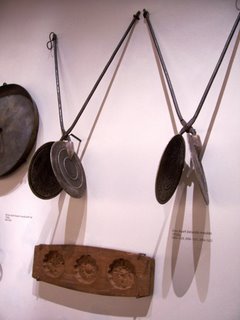Last Friday, I have the pleasure to visit the National Museum of Singapore (NAMOS) with one of my friends, Xiaofen, after our dinner.

It was already slightly after 8 p.m. when we reached there and the weather was rather wet as it was raining that night. Anyway, nothing seemed to have dampened our spirits to check out the National Museum of Singapore. It was Xiaofen's first visit to the National Museum of Singapore after its recent reopening, so I've made a point to show her to the restored Rotunda stained glass, the Glass Passage, and the Concourse.
We checked out three of the Singapore Living Galleries, namely: Film, Fashion, and Food. These galleries "focus on lifestyle themes close to the hearts of Singaporeans"
For the purpose of this very post, I shall only focus on our visit to one of the Singapore Living Galleries: Food. According to a write-up on the museum's website, "This gallery explores the lives of Singaporeans through street food sold by hawkers from 1950s to 1970s"
Xiaofen got me to pay more attention to one of the exhibits that I would normally not have taken much notice of. Previously, before my visit to the museum with her, I had merely took glances of that exhibit thinking that they looked quite like cymbals and I wondered why on earth anyone could cook anything with them. Pardon me, I was awfully ignorant to the functions of the Iron kueh belanda moulds until Xiaofen enlightened me. Now, this is one of the good things about visiting a museum with a friend. One opens oneself to new insights.
Xiaofen shared that when she was younger, she helped her grandmother with the making of love letters. What are love letters? Please don't ask me. Yours truly only know how to eat love letters but I have not much clue how to make them, nor explain what they are like a scholar would.
Xiaofen said that a batter would be mixed. Then the batter would be poured onto the mould which you see right below. I am sorry that they do look like cymbals to yours truly.
Then she went on to share that in making love letters, she would hold the ends of the handles attached to the moulds very tightly. The tighter she holds the ends of the handles, the flatter the love-letters would be. She went on to share that she would then help her grandmother to place the moulds with batter inside their cores over a charcoal-stove so as to cook the love-letters. It was great that the museum happened to have an exhibit of what looked like a charcoal stove so Xiaofen very delightedly pointed me to it.
 The charcoal-stove. It can also be used to cook satay.
The charcoal-stove. It can also be used to cook satay.Xiaofen even went on to elaborate how she had managed to make the love letters obtain their nice round shape. She said that after removing the moulds with the cooked batter from the stove, she would use a knife to trim off the parts of the love letter that stuck outside the perimeters of the moulds. After which, she would remove the flat, round love letters from the moulds and take time to roll each of the love letters with a wooden stick.
The very first set of photos that you see on this post is taken by Little Miss May. I noticed the version of love letters (also known by some as Kuih Kapit) that she makes is the folded type. Folded or rolled, I love the fragrant smell of love letters. The good quality love letters taste yummy too.
Now, I like the idea of learning something new everyday. One of the most fascinating things that often happens when I visit a museum is that I don't just learn about the past, I tend to get to learn something new too!
...But I have two unanswered questions: What is the difference between kueh belanda and kuih kapit? Are the moulds meant to make kueu belanda and kuih kapit different?
**
Do check out these related links:
oh, sweet letters of love (by Little Miss May)
http://www.nationalmuseum.sg/
**
For those who wants a recipe of love letters, I've managed to find one here: http://kuali.com/recipes/viewrecipe.asp?r=305
**
Here are several other blogs that describe about the making of love-letters:
Traditional goodies: Kueh Kapit (by Gentle Ethereal Musings)
The Making Of Kuih Kapit aka Love Letter (by Che-Cheh)
Kueh Kapit (by Brain ooze)
**
Credits:
Special thanks to Little Miss May for giving me permission to use two sets of her photos here.




2 comments:
how sweet! a really nice post together with your photos of NAMOS. yup, there are those who roll the love letters too, though we find it easier to store when it's folded. thanks for linking up to my post! :)
yes the museum has truly reinvented itself. a must see for every sporean!
Post a Comment